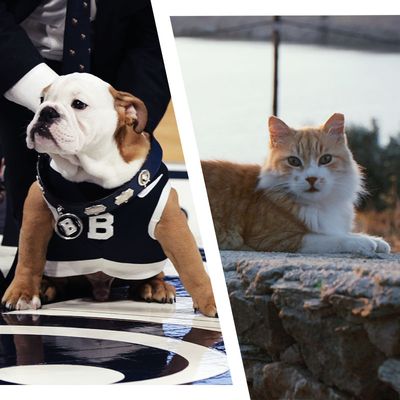
With Americans still divided over the COVID vaccine, critical race theory, and the resurrection of Bennifer (jk on that last one, everyone is pro-Bennifer, except maybe A-Rod), Netflix has dared to stoke another controversy by releasing a second season of Dogs, the docuseries that salutes canine greatness, on the same day as a new feline-focused docuseries called Cat People.
In a nation where we regularly fight like cats and dogs, Netflix has now asked us to fight over cats and dogs. Pick a side, the streaming behemoth has implied. You’re either with the dogs or you’re for the cats. Choose.
Of course, you could always watch both, which, given the length of the seasons that dropped today, is pretty doable. The second season of Dogs, finally following up on the first that arrived back in 2018, consists of four episodes that run roughly 50 minutes apiece, while Cat People offers six episodes, each about a half-hour in length. Why are the installments of Cat People shorter? Because cats don’t have the energy for all this bullshit and you should appreciate that they even gave you 32 minutes of their time. [Licks paws in righteous indignation.]
The shows overlap quite a bit in terms of sensibility, themes, and even storylines, which makes sense since executive producer Glen Zipper developed both of them. Dogs season two and Cat People focus more than one episode on the importance of pet-rescue organizations, particularly in international locales where strays exist in abundance: Dogs zeroes in on a priest in Gravatá, Brazil who has spearheaded adoption efforts there, while perhaps the loveliest episode of Cat People spends time with Joan and Richard Bowell, a couple who created a cat sanctuary on the overrun Greek isle of Syros. (According to the episode, there are 25,000 human residents living in Syros, and an estimated 13,000 cats on the island.) And naturally, the cuteness factor frequently runs high in both, with cameras capturing tiny, 10-day-old kittens nursing on itty bitty bottles or curious puppies poking their snouts directly into the lens.
Several episodes are also guaranteed to make tears stream down the cheeks of everyone watching. I honestly can’t even discuss the first episode of Dogs season two — “Much Ado About Blue,” an ode to Butler Blue III, a.k.a. Trip, the third live bulldog mascot in the history of Indianapolis’s Butler University — without sounding like Rita Wilson talking about An Affair to Remember in Sleepless in Seattle: “And then the current Butler mascot announces plans to retire, and then they find the next mascot, who’s just a wrinkly little bulldog puppy, and THEN the head of the university’s mascot program has to get a major medical procedure …” [Speaks incoherently through jagged crying.]
Both Dogs and Cat People are not shy about making you feel all the feels, but they come by those feels honestly, by spending time with their subjects, both human and animal, and showing how the bonds between them can be life-altering. When Leland Melvin, the retired astronaut whose photo with his dogs went viral, decides to hike Colorado’s Columbia Point to see a plaque dedicated to his colleagues who perished in the Space Shuttle Columbia, he brings those same Rhodesian Ridgebacks to guide him up the mountain. During that hike, directors Daniel Junge and Steven Leckart (who also oversaw Netflix’s recent docuseries about the Challenger disaster) capture the illuminated tent that houses Melvin and his pups beneath a full moon, an image that gives equal weight to the beauty of Melvin’s experiences in outer space and his earthbound life with the dogs he considers his children. Similarly, an episode of Cat People called “Copycat” follows a Japanese artist named Sachi who creates stunningly realistic, three-dimensional needle felt art of people’s cats and found an artistic calling and identity for herself in the process. When Sachi presents a finished, framed piece that depicts a gorgeous Russian Blue named Miyu, Miyu’s owner and her sister are overcome with emotion, and so is Sachi.
Both of these shows offer proof that animals can fill in the gaps between individuals and enable connections that couldn’t be made without a barking or meowing intermediary present. Dropping new episodes of Dogs and Cat People may at first seem like a cheeky way to reignite an old argument about which pets are superior. But what these Netflix shows actually do is suggest that divides can be overcome — at least temporarily — by the world’s fur babies, who can crack open even the hardest of human hearts.





